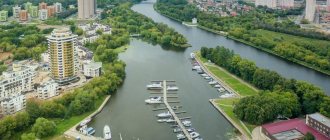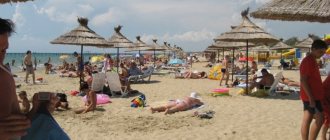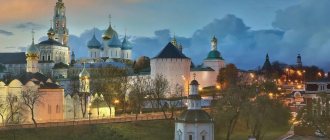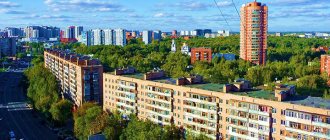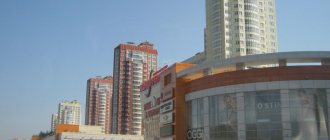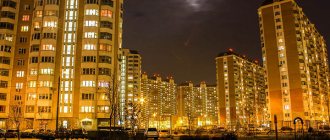Infrastructure
Transport. The city has a fairly developed transport system. The federal highway Moscow - St. Petersburg passes through the settlement. In addition, there is a bus service to the capital. At the city railway station, which is called “Khimki”, stops are made by both commuter and high-speed electric trains. The city itself has a fairly developed and extensive public transport network, which includes trolleybus and bus routes.
Education. The city's infrastructure is at a high level and includes about sixty kindergartens located in different areas of the village. Also in Khimki there are more than 30 school education institutions, including lyceums and gymnasiums with various specializations. In addition, the city has the opportunity to receive secondary technical and higher education in various specialties.
Culture. Almost every lover of cultural recreation will be able to arrange his leisure time in the city due to the large number of theaters, palaces of culture, cultural and entertainment centers, art studios, children's art centers, cinemas, museums and libraries. In addition, various cultural and entertainment events are constantly held in Khimki, which are organized by both the local administration and commercial organizations.
Medicine. The city of Khimki has a fairly developed public health care system. In every district of the village there are pharmacies and clinics within walking distance. In addition, there are specialized hospitals, dispensaries and rehabilitation centers. The city also has a large number of private medical clinics of various specialties.
Sport. Sports lovers and adherents of a healthy lifestyle will be able to choose a sporting hobby in the city to suit their taste. There are stadiums, training centers, fitness clubs, ski slopes, a golf club, a yacht club, a sports complex and the main sports facility of the city, the Khimki Arena. To the delight of football fans, the village has its own football team, which plays in the Premier League and has twice become a Russian Cup finalist.
Trade. The retail network of the settlement is at a high level and is represented by: shopping malls, department stores, business centers, shopping centers, chain food stores and markets. Here you can find both specialized stores and complexes where many different brands are represented.
Khimki
Etymology
The city of Khimki near Moscow received its name from the river on which it was built. How the river got its name is not entirely clear. In ancient times, in different villages that stood on this river, it was called differently: Khynska, Khinska, Khimka, Khinka. The final form - Khimka - was established no more than two centuries ago. The name of the river can be associated with the word “khin”. This dialect word was used mainly in the Ryazan principality and meant “nonsense”, “nonsense”, “insignificant thing”. Consequently, Khimka is a small, insignificant river.
According to one of the folk tales, the river got its name after the daughter of a local rich man, Khimka, drowned in it. Whether it was an accident or suicide has not been established. There is also a Baltic version of the origin of this word. Middle Lithuanian himinas means "moss". The name is also associated with the name Efim (in common parlance – Fimka or Khimka). It is assumed that the original name was rethought under the influence of the word “chemistry” that came into use.
Kozmodemyanskoe village
The first mentions of Khimki date back to the 16th century. In documents of those years she is called differently: Khinka, Khilka, etc. However, we are undoubtedly talking about the same river. One of the most important land roads, connecting Moscow with Novgorod and Tver, passed through the river. The road passed near the village of Kozmodemyanskoye. The owners of the village were the boyars Kuchka and Chubarov. In 1585, the village became the patrimony of the future Tsar Boris Godunov. Many battles took place on the territory of the estate. In 1608-1609, a battle took place on these lands between Polish-Lithuanian invaders and Russian soldiers. The village was completely destroyed by the enemies. Kozmodemyanskoe was restored and for two centuries passed from one owner to another.
In 1812, the territory of the village again found itself in the combat zone. Residents of Kozmodemyansk and surrounding settlements actively participated in the fight against foreigners, joining the partisan movement.
The last owner of Kozmodemyansky was the merchant Patrikeev. He bought an estate that was burned down by peasants in 1905. A country mansion was built according to a new project. Soon the estate began to be called “White Pillars” thanks to the white columns located at the entrance to the estate. After the revolution of 1917, the mansion was taken away from Patrikeev and became public property. In 1918, a sanatorium for tuberculosis patients was organized in this mansion. The sanatorium was opened on the initiative of V.I. Lenin. One of the best doctors of that time, F. Getyev, who treated the leader of the proletariat himself, was transferred here. Soon Lenin visited the sanatorium again and was dissatisfied with its improvement. Repairs to the medical facility have not yet been carried out. There was no electricity in the building. Lenin demanded immediate repairs and electrification of the premises. The construction team leaders had to make a daily report on the work done. Vladimir Ilyich repeatedly visited the sanatorium not only to exercise control. He was attracted to hunting in these parts.
Settlements on the site of modern Khimki
Other settlements also became part of modern Khimki or the Khimki region. After the founding of St. Petersburg, the road called Tverskaya became known as the St. Petersburg tract. Several villages appeared along the tract: Kobylya Luzha, Black Mud, Butakovo and many others. It was decided to improve the quality of the road connecting St. Petersburg and Moscow. In 1722, the tract was reconstructed: a log flooring, made specifically for repair work, was covered with sand and clay. Reconstruction took 24 years. Despite the fact that so much time and effort was spent on reconstruction, the quality of the new road was not high. Empress Catherine II, who was passing through here, was dissatisfied with the newly repaired highway. Her carriage got stuck in the mud near one of the villages. The Empress had to wait a long time before the servants and local peasants finally pulled out the carriage. Having lost patience, Catherine called the village “a damned mare’s puddle.” So the village got a new name. Residents of Kobylya Luzha repeatedly turned to the empress with a request to rename the settlement. However, they failed to achieve the renaming. The village received its modern name only during the Soviet years. They called it New Puddle.
On the site of the current city of Khimki, 500 years ago there was the village of Kozlovo, surrounded by several small settlements, wastelands and abandoned villages. Local settlements received their names from the names of churches or from the names of their owners (Kirei Gorin, the Kozlov family). Villages and villages located on the territory of the Khimki region ( abolished in 2005
), were considered sufficiently populated. Each village had at least forty houses. Up to two hundred peasant families usually lived in the village. All buildings were wooden. The first stone building appeared in 1678. This building was the Vladimir Church, located in the village of Kurkino. Over the next centuries, several more churches were built on the territory of the future Khimki region. They were the only stone buildings.
Khimskaya station and station village
The city of Khimki itself began in the 19th century. In 1851, the Khimskaya station was opened (today it is called the Khimki station). The station belonged to the St. Petersburg-Moscow Railway. A station village arose not far from Khimskaya. Trains stopped at the station for no more than ten minutes. Khimskaya was the first station after Moscow. She was placed in fourth grade. There were the cashier, the station master with his assistant and the gendarme. A wooden platform, a station building, a hotel, a residential building for railway workers and some other outbuildings were built on Khimskaya. There was a buffet located in a tent not far from the station building. By the end of the 1860s, about forty people lived permanently at the station. These were mainly railway and station workers. The station was separated from the village of Kozmodemyanskoye by a ravine and a wooded wasteland.
The station village gradually grew and eventually merged with the village. The main street of Kozmodemyansky - Kuzminka - went around the ravine and stretched all the way to the station. At the beginning of the twentieth century, there were already about fifty households in the station village. A post office, a private pharmacy, a telegraph office, a tavern, 2 shops and a restaurant were built in the village.
The initiator of the construction of a railway that could connect Moscow with the new capital was Nicholas I. In 1838, traffic was officially opened in Russia along the country's first railway, called the Tsarskaya railway, which connected St. Petersburg with Pavlovsk. Then the need arose to connect St. Petersburg with Moscow by rail. In September 1841, Nicholas I received the project for the St. Petersburg-Moscow railway. The project was considered revolutionary for its time. The railway was supposed to use steam traction. Horse traction was several times more expensive and slower. Construction of the road began in 1843 and ended in 1851. The railway was of great national importance, as it connected the 2 main cities of the Russian Empire.
After serfdom was abolished, most of the landowners' estates in the vicinity of the Khimki station passed into the hands of the bourgeoisie and nobility. The new owners of the estates sought to benefit from their proximity to Moscow. The bourgeoisie began to rebuild its economy on a capitalist basis. Land began to be sold, and estates were rebuilt as country dachas. The lifestyle of the common people has also changed. Many began to rent out their houses for the summer to poor Muscovites who did not have the opportunity to rent a dacha from the “bourgeoisie.” Some peasants took up carting or selling agricultural products to visitors. There were also those who went to work on the railway or went to Moscow to earn money.
Khimki at the beginning of the 20th century
By the end of the 19th century, the first enterprises appeared on the territory of the future urban district of Khimki. Not far from the village of Yurovo there was a cloth factory, owned by Prince Menshikov. Then it passed to the merchant K. Ganke. Not far from the cloth production, a dyeing factory of the Giraud family was opened. The Izhisha cloth factory was built near the village of Gavrilovka. At the beginning of the twentieth century, A. Ivanov became the new owner of the factory. The company began to produce woolen fabrics. A wool spinning factory and a brick factory appeared not far from the village of Nikolskoye.
In 1917, after the victory of the revolution, numerous rallies were held in the Cherkizovskaya volost. The protesters demanded that the Provisional Government transfer the land to the peasants and immediately end the First World War. In each volost, volost self-government was created. Vocal deputies were elected to the volost assembly. Peasants who had reached the age of twenty were required to participate in the elections. The Cherkizovsk volost government was located in Skhodnya (now a microdistrict of the city of Khimki). Thus, the volost began to be called Skhodnenskaya. The revolution took place for the volost without any major shocks.
In 1918, a new volost was formed - Ulyanovskaya. Khimki becomes the administrative center of the volost. Ulyanovskaya included several more volosts: Durykinskaya, Cherkizovskaya, part of Vsekhsvyatskaya and Eremeevskaya. Until 1928, there were 4 settlements and 74 villages on the territory of the Ulyanovsk volost. The First World War and the Civil War, as well as the policy of war communism, caused enormous damage to the peasant economy of settlements in the area of the Khimki station. Military actions significantly slowed down the pace of development of the volost. Mortality increased sharply, caused by famine and numerous epidemics. Part of the male population of the volost did not return from the First World War. The village of Khimki in those years consisted mainly of one-story wooden houses. Apart from the Tsarskoye Highway, there were no streets paved with stone in the village. There was also no sewerage, running water or electricity. However, life in the volost gradually improved. Already in 1918, on the initiative of some railway workers, the first Soviet railway school was opened, located at the former dacha of the owner of the Presninskaya manufactory. The school could accommodate up to one hundred and fifty people at a time. The duration of schooling was 5 years.
Until the end of the 1920s, Khimki retained the character of a dacha area. In the early 20s, about two thousand people lived in the village. In 1926 the population grew to 2,876 people. The population growth is due to the fact that the station village merged with the dacha village of Petropavlovsky. A library, a fire brigade, an outpatient clinic, and a club appear in Khimki. In 1919, a first-level school was opened. The initiator of the opening was the former nobleman Vladimir Bolotov. At the end of the 20s, this educational institution was transformed into a school for peasant youth. The school was located where the park named after L.N. Tolstoy is located today. The director of the educational institution was Bolotov himself. He was also a teacher.
From the end of the 20s, the industrial growth of the station village began. A knitting artel appeared here, which over time turned into a knitted underwear factory. Due to the intensification of construction, the Nikolaev Brick Factory was forced to work year-round. Previously, it only worked seasonally. In the early 30s, the plant was reconstructed. During these same years, a furniture factory was built. A small artel for the production of mechanical products “Spartak” becomes a large enterprise. The settlement of the workers' artel was located on modern Spartakovskaya Street. New settlements appeared around Khimki: the villages of Mebelny, Pervomaisky, Central, Chkalovsky, Grabarovsky, Lobanovsky. In 1932, an aircraft repair plant was founded in Khimki. The first 2 multi-storey buildings were erected on Moskovskaya Street in the late 30s.
In the pre-war years, many new institutions were built in Khimki. In 1937, construction of the canal connecting the Volga and Moscow rivers was completed. The Northern River Port was created in Khimki. On the site of the village of Kireevo (the left bank of Khimki), a new village was built - Levoberezhny. Not far from the village, the dacha of the manufacturer Prokhorov has been preserved. The State Library Institute was transferred here in 1930 (today it is called the Moscow State University of Culture and Art), founded by N. Krupskaya. Since the canal cut off the station from the village, N. Krupskaya took the initiative to build the Levoberezhnaya platform.
Khimki became a city at the end of March 1939 as part of the working villages of Lobanovo, Khimki, Petrovskoye and two dacha villages - Nikolaevsky and Petropavlovsky. In 1940, Khimki became the administrative center of the newly formed Khimki district.
During the Great Patriotic War
Khimki became the closest settlement to the capital that the Nazis managed to reach during the Great Patriotic War. There is a legend that in mid-October 1941, a detachment of motorcyclists unexpectedly approached the city and seized the Leningradskoye Shosse bridge. The detachment, however, was destroyed. There is conflicting information about exactly where this happened. According to the research of historian A. Khorkov, German motor reconnaissance actually approached the bridge. But there was no fight. After examining the area, the Nazis left. According to another version, on October 16, a militia of students, women and teenagers was assembled in Khimki. It was this group that intelligence met. The Germans broke the resistance and reached Sokol. They still did not dare to enter the city. The scouts then returned to the bridge, where they took up a defensive position, awaiting reinforcements.
By decision of the State Defense Committee, they began to hastily build an “Additional defensive line” in Khimki. At the end of 1941, the aircraft repair plant was evacuated to Tashkent.
In 1945, electrification of government buildings and private farmsteads began in war-stricken villages. Bus service between all settlements in the region, Khimki and Moscow has been resumed. One of the first railways in the Soviet Union was Oktyabrskaya. The first years of peaceful life were marked by cultural, economic, household and railway construction.
Rocket Science Center
In the post-war years, Khimki became one of the most important centers of Soviet rocket science. The city housed the main enterprises of several scientific and production associations of the USSR, which had defense significance. Design Bureau Energomash, which was among these enterprises, provided development of engines for intercontinental ballistic missiles. IKB Fakel was developing anti-aircraft missiles. The Lavochkin NPO was engaged in the development of air-to-ground and surface-to-air missiles, as well as wide-spectrum spacecraft, cruise missiles and lunar rovers.
City streets
Khimki developed not only in the direction of rocket science. One of the areas of development was logging. In the 50s and 60s, a square was formed in front of the city administration building in Khimki. During those same years, many new streets appeared in the city due to intensive construction. Zheleznodorozhnaya Street runs parallel to the railway track. Aptechnaya Street appeared, connecting the first pharmacy and the station. Skoroprogonnaya Street, which ran among the barracks of Old Khimki, was renamed Pobeda Street in 1945. Many new streets were named after heroes of the Great Patriotic War, for example, Kudryavtsev Street, which was named in honor of Guard Lieutenant N. Kudryavtsev, who died in 1943 and destroyed 15 enemy tanks in one battle. One of the streets is named after the pilot M. Rodionov. The title of Hero of the Soviet Union was awarded to Rodionov only in 1948. The residents of Khimki did not forget to immortalize in the street names the names of those who were involved in the improvement of their hometown. The streets of M. Rubtsova and I. Melnikov bear the names of honorary citizens of the city who made a huge contribution to the development of Khimki. From the village of Nagornoye there is a highway named after the village of Nagornoye. In the 70s, a nine-story library building was built in the Levoberezhny microdistrict.
Modern period
In the mid-80s, a significant part of the territory of the Khimki region was assigned to Moscow. As a result, the area was divided into two parts. At the end of the 90s, a trolleybus was launched in Khimki, connecting 2 parts of the city. The trolleybus follows Yubileiny Avenue, Mayakovsky Street and Mira Avenue. By the end of the last century, 2 cinemas, 3 stadiums, many shops, secondary schools, the Rodina Palace of Culture, an art school, a technical school and a university of culture appeared here. In 1999, a McDonald's cafe was opened in the city.
The annexation of part of the Khimki district to the territory of Moscow was due to the fact that at the turn of the 20th-21st centuries there were no free and suitable areas for construction left in the capital. A huge number of offices of commercial companies and enterprises were demolished in the Moscow region. In the early 2000s, Khimki, along with other Moscow suburbs, became an area of mass residential development. One of the by-products of this solution to the problem was a transport collapse on the Leningradskoe Highway, which connects Khimki and the capital. In 2004, some settlements of the Khimki region were united with each other. Thus, the village of Uskovo and the village of Firsanovka were merged with the city of Skhodnya; the village of Vashutino and the holiday village of Starbeevo became part of Khimki. A decision on whether Khimki will be part of Moscow has not yet been made.
In recent years, Khimki has gained fame thanks to the movement to preserve the Khimki Forest. Several conflicts occurred during the movement and were widely reported in the media. In 2010, a group of young people protesting against deforestation vandalized the city hall building.
Sights and memorable places
In Khimki there are famous monuments and memorials dedicated to the heroic exploits of Red Army soldiers during the Great Patriotic War:
· The opening of the composition “Feat of Mercy” took place in May 2005. It is located on the territory of the park named after Maria Rubtsova. The bronze memorial, reaching a height of five and a half meters, is placed on a granite pedestal. The monument is dedicated to young girls from Khimki who, as nurses, went through the entire Great Patriotic War and were able to save thousands of lives.
· The “Giver of Life” Memorial was opened in May 2015 and is located in the city itself. It bears the names of about 2,500 city residents who heroically gave their lives defending their homeland during the Second World War. The composition consists of two slabs in the form of a cut star with hands, a bird and a St. George's ribbon depicted on them. Also on the sides there are twelve granite steles with surnames printed on them. In the granite base of the monument, there is a book, with the missing residents of the city of Khimki listed in it.
· The monument to “Those who Defended the Fatherland” was opened in 1965, and in 2009 it was restored. It is located on the street. Victory. The monument was erected as a memory of the heroic exploits of the Red Army soldiers. The unique titanium stele was manufactured through the efforts of NPO Energomash.
· The opening of the “LA 7” Monument took place in late spring 2007. It is located near the Dubki park. The monument was made by workers of the plant named after. Lavochkin using original drawings of the aircraft. It personifies the memory of the heroic Soviet pilots of military aircraft and logistics workers, whose work is difficult to overestimate.
Property Features
Mass housing construction began in Khimki in the 1930s, when the village of Levoberezhny and the northern part of the future city were built, and in the following decades - the Dubki area near the canal.
Then the construction of residential buildings moved to the south, where the city center then moved (the so-called New Khimki). Subsequently, housing was built for workers in the aerospace industry, which the city specializes in to this day.
If you are interested in apartments in new buildings in Khimki, consider the advantages of this city.
Firstly, Khimki occupies a strategically advantageous position between Moscow and Sheremetyevo - it has transport accessibility, jobs, and an economically developed, and therefore socially prosperous, area.
Secondly, there is a favorable ecological situation, an abundance of natural resources (forests), proximity to “big water” (the water area of the Moscow Canal, the Khimki Reservoir, the Klyazma and Skhodnya rivers).
Availability of transport in Putilkovo. A former village in the Moscow region is building a lot of real estate.
· The monument “Valor and Glory of Russian Special Forces” was opened in early autumn 2007 and is located on the territory of the park named after Maria Rubtsova. The monument depicts special forces military units that participated in the defense of the Motherland. The monument consists of a column, on its top there is an eagle with spread wings, which holds a machine gun in its beak. There are 2060 names of special forces soldiers on the column.
In addition, the city has parks and public gardens intended for recreation and walking. Due to this, the settlement looks well-maintained and fairly green.

